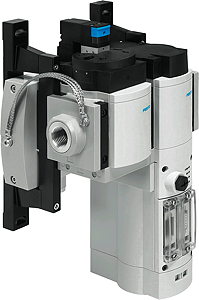- Home » News » Product News
Module saves energy by stopping compressed air leaks

Festo has developed a device that monitors and regulates compressed air supplies automatically to cut energy consumption. When the MS6-E2M module detects a machine is in standby, it shuts down the compressed air supply, thus preventing air from escaping through leaks. It also monitors parameters such as flow and pressure.
Unlike conventional pneumatic service devices, the module intervenes actively in the air supply. “For the first time, the air preparation system is monitoring, diagnosing and notifying maintenance teams based on actual requirements,” explains Festo UK product manager, Steve Sands.
The module can be installed on new machines or retrofitted to older installations and linked to their controls to help operate the machines more efficiently. It can be adjusted manually by the operator, or remotely via Profibus.
When in shut-down mode, the E2M checks an installation for leaks. If it detects pressure dropping by a preset amount, it signals this to the machine’s control system via Profibus.
The module can also be used to switch the compressed air supply on and off by hand. In complex processes, the automatic standby function can be deactivated, allowing plant operators to specify via a PLC whether a machine is in production operation or not.

A condition-monitoring facility gives plant operators instant access to energy- and process-related data. The module can exchange data such as energy consumption and machine availability with a control system via Profibus.
Measured values for flow rates, air consumption and pressure can be called up at any time. Plant operators can use this information for continuous monitoring of machines. It is possible, for example, to determine whether equipment is consuming more air than it did a year ago, how much compressed air is needed for a production batch, and the pressure and flow rate at the time of a machine breakdown.





